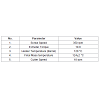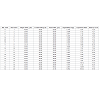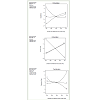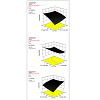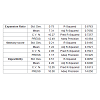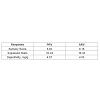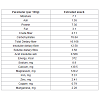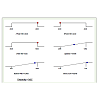Research Article
Optimisation of a Multi-Millet Ready-to-Eat Extruded Snack with Digestibility and Nutritional Perspective
WadikarDD1* Kangane SS2, Parate V2 and Patki PE1
Corresponding author: Dr. Dadasaheb Dattatraya Wadikar, Defence Food Research Laboratory, Siddartha Nagar, Mysore,Karnataka State-570011, India. Tel. +91821-2579081, Fax. +91821-2473468.; E-mail: ddwadikar@gmail.com
Citation: WadikarDD, Kangane SS, Parate V, Patki PE. Optimisation of a Multi-Millet Ready-to-Eat Extruded Snack with Digestibility and Nutritional Perspective. Indian J Nutri. 2014;1(1): 104.
Copyright © 2014 WadikarDD et al. This is an open access article distributed under the Creative Commons Attribution License, which permits unrestricted use, distribution, and reproduction in any medium, provided the original work is properly cited.
Indian Journal of Nutrition | Volume: 1, Issue: 1
Submission: 15/10/2014; Accepted: 20/11/2014; Published: 21/11/2014
Abstract
A blend of flours of Finger millet, Pearl millet and Foxtail millet was attempted to get a nutritionally superior product. The in-vitro starch digestibility of the flours was studied and the blend of flours was used to develop an extruded ready-to-eat snack using response surface methodology. The aim was toachieve a product with optimum extrusion in terms of expansion ratio and a best flour blend to have better digestibility and the overall sensory acceptanceof the product. The central composite rotatable design with flours of three millets (as independent variables) was studied with 20 design points against thethree crucial responses namely, expansion ratio, digestibility and sensory acceptability of the extruded product. The quadratic models were best fit in case ofdigestibility and expansion ratio while for the sensory score linear model was found suitable. The equations obtained were validated for the predictability ofresponses. The proximate composition, mineral and fibre profile of the product revealed its nutritional strength. The product being a ready-to-eat snack has excellent potential for its commercialisation as the raw materials are not costly and are readily available locally.
Keywords: Finger millet; Pearl millet; Foxtail millet; Digestibility; Extrusion; RSM
Introduction
The millets are a group of highly variable small-seeded grasses, widely grown around the world as cereal crops or grains for both human food and fodder. These are important crops in semiarid and tropical regions of the world (in particular in Afro-Asian countries) due to their resistance to pests and diseases, short growing season and productivity under heat and drought conditions. The Finger millet (Eleusine coracana), Pearl millet (Pennisetum glaucum) and Foxtail millet (Setaria italica) are good source of carbohydrate, dietary fibre and micronutrients. The rejuvenated nutritional strengths of millets have made them functional grains. Though different millets are available with localised areas of production and usage, their wide spread use can only be possible through food technological approaches leading to globally acceptable products, so that the health benefits of millets reach to everyone everywhere and can be a booster for the growers of millets.
In past few decades, the consumption of foods mainly based on refined flours has resulted in reduced intake of dietary fibres and other micronutrients as a result of urbanized life styles, changes in practices and level of physical activity. This may be associated with rising affluence induced by developmental transition contributed to increasing prevalence of overweight/obesity [1]. Of late consumer inclination towards foods based on multiple grains has brought the research on multiple grains in for front. However, millets are still considered as the food for poor and traditional consumers because of non-availability of ready-to-use or ready-to-eat convenience food products from the millet [2,3] and also the limited efforts made to diversify its food uses by application of traditional and contemporary food-processing methods [4]. Modifying the staple sources of starch itself by incorporating millets through technological approaches can deliver substantiated health benefits while retaining consumer appeal. The combination of low cost and nutrient rich millets has not been much explored. Extrusion technology, well-known in the plastics industry, has now become a widely used technology in the agri-food processing industry, where it is referred to as extrusioncooking. With the help of shear energy, exerted by the rotating screw, and additional heating of the barrel, the food material is heated to its melting point or plasticizing point [5]. It is one of the contemporary food processing technologies applied for preparation of variety of snacks, speciality and supplementary foods [6] and offers advantages of preparation of ready-to-eat foods of desired shape, size, texture and sensory characteristics at very low processing cost [7]. Extrusion cooking also reduces the anti-nutritional factors, renders the product microbiologically safe and enhances the consumer acceptability [8]. Besides, extrusion cooking of millets offers additional benefits; namely, inactivation of lipases and enhancing the shelf-life of its products. It may be noted that keeping quality of the millet products is normally very poor because of its relatively higher proportion of lipid contents and presence of active lipase in the millet, which facilitates onset of hydrolytic rancidity during storage [9]. The digestibility of nutrients must be known in order to evaluate fully the significance of nutrient concentration. The chemical composition of millets varies with the cultivars, agronomic conditions and soil fertility level, but a generalised composition can be considered for most practical purposes. The carbohydrates are crucial for extrusion and the three millets in the present context have it in the range of 63-73%. An efficient combination of these millets to achieve best possible extrusion with the set conditions and to optimise a product with better digestibility, micronutrient profile and sensory attributes was the aim of the present work.
Materials and Methods
Raw material & its processing
Finger millet (Eleusine coracana), Pearl millet (Pennisetum glaucum) and Foxtail millet (Setaria italica) were procured from local market. The millet grains were cleaned, aspirated manually and ground into fine flour in a table top laboratory mill (City mill, M/sPatel Industries, India). The flour was sieved through 60 mesh sieve for the further processing/ analysis.
Chemicals
All the chemicals and reagents used for analysis were of AR grade and procured from M/s. s d fine Chemicals Ltd, Mumbai and M/s. Himedia Laboratories Ltd, Mumbai and M/s. Merck specialties Pvt. Ltd, Mumbai.
Extrusion Method (Product Preparation)
Extrusion of samples was performed using a co-rotating twinscrew extruder (Basic Technology Pvt. Ltd., Kolkata, India). The main drive of extruder was provided with a 7.5 HP motor (400 V, 3 ph, 50 cycles). The output shaft of worm reduction gear was provided with a torque limiter coupling. The barrel of the extruder received the feed from a co-rotating variable speed feeder. The barrel was provided with two electric band heaters and two water cooling jackets. The die was required to be fixed on the face of barrel by a screw nut tightened by a special wrench provided. The die diameter was selected at 3mm for better expansion such product (Table 1). The twin screw extruder was kept on for 30 min to stabilize the set temperatures and samples were then poured in to feed hopper and the feed rate was adjusted to 4 kg/h for easy and non-choking operation. The product was collected at the die end and kept at 60 ± 0.5 °C in a hot air oven (M/s. Scientific Works, New Delhi) for 4 hours to remove extra moisture from it. The samples were packed in PFP (paper/Al foil/polythene) bags for further analysis.
Experimental Design
A statistical software Design expert® version 8.0 from Statease Inc; USA, was used to construct as well as to analyze the design. Finger millet, Pearl millet and Foxtail millet flours were taken as independent variable with digestibility, expansion ratio and sensory score as the responses. The central composite rotatable design (CCRD) based on these three independent variables resulted in 20 experimental combinations. Such designs are found to be quite useful in several process/product optimisations [10,11]. The center points were selected with ingredients at levels expected to yield satisfactory experimental results. The α-values in the design outside the ranges were selected for rotatability of the design [12]. The independent variables with their actual value ranges taken for study are given in Table 2. The regression analysis of the responses was conducted by fitting suitable models represented by equations 1 & 2.


where, βο was the value of the fitted response at the center point of the design, i.e., point (0, 0, 0); βi, βii and βij were the linear, quadratic and cross product (interaction effect) regression terms respectively and ‘n’ denoted the number of independent variables. The formulations that were fed to the extruder are given in Table 3.
Product (extruded snack) characteristics
Proximate analysis of the extrudate was carried out by standard AOAC procedures [13,14]. Carbohydrate content was estimated by difference and the calorific value of the extrudates was determinedby computation. Final mass temperature was measure using Ray- Temp 38 Infrared thermometer (digital gun (www.etiltd.com). The expansion ratio (ER) of the dried extruded snack was measured as the ratio of the cross-sectional areas of the extruder rods to that of the die. The radial expansion of the extrudates was measured using a Vernier Calliper and the average of 6 measurements was recorded.

In-vitro Starch digestibility: It was determined in the samples using pancreatic α-amylase [15]. 50mg sample was weighed, dispersed in 1.0ml of 0.2M phosphate buffer, 0.5ml of pancreatic α-amylase (1.25mg) added and incubated at 37 °C for 2h. After the incubation period, 2ml of 3-5 dinitrosalicylic acid reagents was added and the mixture heated for 5min in a boiling water bath. The solution was cooled and volume made up to 25ml with distilled water, filtered prior to measurement of the absorbance at 550nm against blank. Maltose was used as the standard and the graph plotted. The values were expressed as mg of maltose released per gram of sample.
Elemental analysis
The elemental analysis of samples was done by ICPOES (JYHoriba, Ultima model). 5g exactly weighed samples was calcinated at 550 °C for 6 hours. The ashes were then diluted in nitric acid finally making a volume of 100ml with acid strength of 2.5% and filtered. Foranalysis, standard operating protocol for JY ICPOES was used with Win-IMAGE software for quantitative analysis. The nebulised sample was transferred to argon plasma. It was decomposed; atomised and ionised thereby the atoms and ions are excited. The intensity of the light emitted when the atoms/ions return to lower levels of energy was measured. Each element emits light at a characteristic wavelength and these lines were used to quantitative analysis after calibration.
Sensory Evaluation
All the combinations of the Multi-millet snack were evaluated for their sensory score consisting colour, aroma, taste, texture and overall acceptability on 9-point hedonic scale by semi-trained panel of 15 members. The 9-point Hedonic scale grading was as follows:9=Excellent, 8=Very good, 7=Good, 6= Good above fair, 5= Fair, 4= Fair above poor, 3= Poor, 2= Very poor, 1= extremely poor. The statistical analysis for significance was carried out using IBM® SPSS® 19 trial version software.
Results and Discussion
The extrusion process being a high temperature short time (HTST) process, the temperature and equilibrium moisture of the flour plays an important role in gelatinization process which in turn influences the texture, physical characteristics such as expansion ratio, appearance and determines the sensory quality of the product. Extrusion of different millet such as kodomillet [16], foxtail millet [17], finger millet [18], pearl millet [19] have been reported mainly reported the extrusion parameters and the physicochemical properties of the extruded product. The combination of two millets and otherblends’ extrusion also has been reported [20,21]. The recommended moisture by extruder manufacturer was 10-16% depending upon the material being extruded. The multigrain flour mix was extruded with 10-14% equilibrated moisture and at temperature of 110-120 °C. The good extrusion in terms of expansion ratio occurred with 11% moisture and 110 °C, Hence, the same was used for further studies. The standardised parameters of extrusion process are represented in Table 1. The extrusion cooking, in general improves the sensory and nutritional profile of the processed native material. Digestibility being one of the important criteria for the nutritional output from a starchy product, it was analysed in the fresh flours of the three millets viz. finger millet, pearl millet and foxtail millet. Results revealed that among the millets, in-vitro starch digestibility of finger millet flour was high as compared to that of foxtail millet and pearl millet i.e. 7.32mg/g, 5.77 mg/g, and 4.675 mg/g, respectively. The higher digestibility of finger millet can be attributed to comparatively higher starch content and lower gelatinisation initiation temperature. The low starch digestibility of pearl millet has also been reported [22]. The in-vitro starch digestibility of raw flours of fingermillet was reported in the range 7.2-9.9 mg/g [23].
For forming a nutritionally superior multi-millet blend, the pearl millet being the better source of minerals was kept at higher level, while finger millet and foxtail mullet were varied at similar levels.The initial trials of multimillet extrusion with optimised conditions were done with flours in the ratio as Pearlmillet (40): Foxmillet (30): Fingermillet (30) to get insight of the extrusion pattern of the blend.
For optimising the best proportion of the millet flours, statistical designing of the experiment using CCRD was done. Response Surface Methodology (RSM) uses polynomial model with the help of least square technique to fit the response behaviour with minimum possible points. Ozer et al. [24] used RSM to analyze the effect of screw speed (220-255rpm), feed moisture (10-11.5%) feed rate (22-30kg/h) on the physical properties of nutritionally balanced extruded snacks food during its development. Larrea et al. [25] evaluated the effects of operational parameters of extrusion on functional properties during preparation of biscuit-like cookies incorporating orange pulp. In the present study, for developing a multi-millet extruded snack, total of 20 design points were obtained for a CCRD with three independent variables. Table 3 represents the various combinations studied and the responses observed. The extrusions were carried at 110 °C and product analysed for ER and sensory score. The responses studied had direct effect on the quality and were dependent directly on specific composition of the product. The expansion ratio is a primary attribute to judge quality of the snack product and suitability of raw material for extrusion. The effect of all the variation in levels of independent factor in the design, on different response can be seen in the predictive graphs (Figure 1) for each response of the product with optimum level.
The in-vitro starch digestibility ranged from 2.8 to 6.8mg/g in the experimental space. Finger millet and foxtail millet had significant effect on digestibility of the flour blend. The increase in the level of finger millet leads to proportional increase in digestibility of the flour blend and vice versa. The effect was reverse in case of pearl millet while the foxtail millet marginally improved the digestibility with increase in its level. It has been reported [20] extrusion of sorghum, pearl millet or fingermillet along with mung beans and milk powder blend; however the in-vitro carbohydrate digestibility was not different markedly from the unprocessed blends. While the carbohydrate digestibility of cereals and millets was reported [26] to be improved substantially post extrusion. However, effect of blending the multiple millets on their digestibility has not been dealt wherein the present work (Figure 2) reveals that the blending may affect the digestibility of the flours adversely. The in-vitro digestibility of the optimised blend was increased post extrusion so as to get a multimillet blend with better digestibility. Deshpande and Poshadri [27] reported on foxtail millet composite flours extrusion however digestibility aspect was not reported.
The ER of the extruded product ranged between 4.91 and 10.89. It was influenced in descending order by pearl, foxtail and finger millets. The increase in pearl millet level proportionately increased the ER while the increased level of foxtail mile drastically reduced ER. the finger millet did not influence the ER of the extrudares significantly. The reduced ER with increase in the level of foxtail millet has also been reported in an extruded product prepared from a composite flour blend. Expansion ratio for various rice sorghum blend extrudates has been reported [21] between 9 to 12.
To fit these responses with regression models to represent them, ANOVA and model diagnostic tools of design expert software were used. The details of the ANOVA for each response are represented in Table 4. Not much information on the digestibility of millet blends could be available in the literature. Many times a quadratic model has been reported to be best fit for the sensory score response [11]. However, in the present context the sensory score very clearly influenced by variations the ingredient levels; a linear model was found highly suitable. The digestibility and ER response showed a quadratic pattern and the same models were fit with non significant lack of fit. The coefficients of each term of the models fit for the respective response are represented in terms of equation below.
With such weird responses to the variations in the ingredient levels (independent factors), optimization of the levels to get best combination was resolved through graphical optimisation procedure of design expert software by giving criteria to maximise ER, digestibility as well as the sensory score. Higher desirability value indicates how best the criteria given for optimization are meeting. The optimised solutions obtained for the ingredient levels and expected response values with a desirability value of 0.822 indicated the same (Figure 3). This was validated by conducting the experiment and comparing with the predicted values of the responses to the actual observed responses. The observed value of digestibility response for the optimised combination was 4.65mg/g against the prediction of 4.65mg/g. while the actual observation. The expansion ratio obtained was 10.24 while the predicted value was 10.32. In case of third response, i.e. sensory score of the extruded snack; it was observed that the actual obtained score (8.02) and the predicted score (8.18) were almost similar. As the observed values of all the three responses for the extruded snack are in well concurrence with predicted values, it was concluded that the models could be used for predicting the responses with varied levels within the design space. The equations generated during the process can be used to predict the respective responses within the rotatable space of the design matrix. The optimized multi-millets extruded product was analyzed for proximate composition. Digestibility of optimised extruded product was 8mg/g and the sensory score obtained was 8.18 on the 9-point hedonic scale. The nutritional chemical composition of the RTE extruded snack is represented in Table 5 and Table 6. The carbohydrate rich multi-millet snack gives good amount of dietary fibre with 372 KCal energy per 100g of the product. The iron & calcium contents (mg/100g) of fingermillet (3.9 & 350), pearlmillet 11.0 & 42 and foxtail millet (2.8 & 31) have been reported [28]. The mineral profile of the extruded product determined by ICP-OES revealed that the product is an excellent cereal source of iron (5.31mg %) and calcium (139.5mg%). The multi-millet extruded snack also provides fair amounts of magnesium, sodium zinc and manganese.
Criteria analysis showed that 90% of the children (patients) were from lower classes while 8% from middle classes and 2% from upper classes. Their feeding status pointed that 85% of the children are associated with mal-feeding while 8% were full-quenched breastfeeding and others were dependent on artificial (2%) as well as mixed (5%) feeding. Patients distribution showed that almost 80% of the children were 50-75 cm, 18% were 70-100cm and only 2% children were >100 cm (Figure 2).
Conclusion
The extrusion of multiple millets is an interesting phenomenon as the starches of different nature are co-extruded and the product parameters are influenced by synergetic effects. The product was optimised using RSM by maximising the responses such as expansion ratio, digestibility and the overall acceptability of the product. The developed product is a nutritionally superior product compared to individual millets. The concept of multi-millet combinations in development of products needs to be carefully executed as it affects the digestibility of the product. The developed extruded product offer better digestibility & nutrition in terms of mineral profile.
References
- Sindhi R, Jain S. (2006) Reduction of energy density in some commonly consumed snacks. Journal of Food Science and Technology 43: 148-150.
- FAO (1995) Sorghum and millets in Human Nutrition, Food and Agricultural Organisation of United nations, Rome, FAO Food and Nutrition Series: 27.
- Varriano-Marston E, Hoseney RC (1983) Barriers to increased utilization of pearl millet in developing countries. Cereal Foods World 28: 392.
- Ali AM, El-Tinay HA, Abdalla HA, (2003) Effect of fermentation on the in vitro digestibility of pearl millet. Food Chemistry 80: 51-54.
- Leszek M, van Zuilichem DJ (2011) Extrusion-Cooking and Related Techniques In: Extrusion-Cooking Techniques: Applications, Theory and Sustainability. p 1-24.
- Harper JM, Jansen GR (1985) Production of Nutritious Foods in Developing Countries by Low-Cost Extrusion Technology. Food Reviews International 1: 27-97.
- Guy, R. (2001) Extrusion cooking: technologies and applications, Woodhead Publishing, ISBN 978-185-5735-59-0, Cambridge, United Kingdom.
- Nibedita M, Sukumar B (2003)Extrusion cooking technology employed to reduce the anti-nutritional factor tannin in sesame (Sesamum indicum) meal. Journal of Food Engineering 56: 201-202.
- Kaced I, Hosney RC, Varriano-Martson E (1984).Factors affecting rancidity in ground pearl millet. Cereal Chem 61: 187-192.
- Wadikar DD, Majumdar TK, NanjappaC, Premavalli KS, Bawa AS (2008) Development of pepper based shelf stable appetizers by Response surface methodology (RSM). LWT Food Science and Technology 41: 1400-1411.
- Wadikar DD, Nanjappa C, Premavalli KS, Bawa AS (2010) Development of ginger based ready-to-eat appetizers by Response surface methodology. Appetite 55: 76-83.
- Thompson D (1982) Response surface experimentation. Journal of food Processing and Preservation 6: 155-188.
- AOAC (1975) Official Methods of Analysis 12th edn. Association of Official Analytical Chemists’, Washington DC.
- AOAC (1984) Official Methods of Analysis 14th edn. Association of Official Analytical Chemists’, Washington DC.
- Singh U, Kherdekar MS, Jambunathan (1982) Studies on desi and kabuli chickpea cultivars. The levels of amylase inhibitors, levels of oligosa ccharides and in vitro starch digestibility. Journal of Food Science 47: 510-512.
- Geetha R, Mishra HN, Srivastava PP (2012) Twin screw extrusion of kodomillet-chick pea blend: process parameter optimisation, physicochemical and functional properties. Journal of Food Science and Technology 51: 3144-3153.
- Ushakumari SR, Latha S, Malleshi NG (2004) The functional properties of popped, flaked, extruded and roller dried foxtail millet (Setaria italica). International Journal of Food Science and Technology 39: 907-915.
- Sawant AA, Thakor NJ, Swami SB, Divate AD (2013) Physical and sensory characteristics of ready-to-eat food prepared from finger millet based composite mixer by extrusion. Agric Eng Int: CIGR Journal 15: 100-105.
- Sumathi A, Ushakumari SR, Malleshi NG (2007) Physico-chemical characteristics, nutritional quality and shelf life of pearl millet based extrusion cooked supplementary foods. Int J Food Sci Nutr 58: 350-362.
- Malleshi NG, Hadimani NA, Chinnaswamy R, Klopfenstein CF (1996) Physical and nutritional qualities of extruded weaning foods containing sorghum, pearl millet, or finger millet blended with mung beans and other nonfat dried milk. Plant Foods Hum Nutr 49: 181-189.
- Lakshmidevi N, Shobha S, Sajid Alavi, Kalpana K, Soumya M (2012) Utilisation of extrusion technology for the development of millet based complimentary foods. Journal of Food Science and Technology 51: 2845-2850.
- Kawatra SSA, Singh G (2003) Recent Technologies in Pearl Millet and Sorghum Processing and Food Product Development Proceedings of the Expert Meeting ICRISAT, Patancheru Andhra Pradesh, India pp 75-104. CFC Technical Paper No. 34.
- Roopa S, Premavalli KS (2008) Effect of processing on starch fractions in different varieties of finger millet. Food Chemistry 106: 875-882.
- Ozer E A, Ibanoglu S, Ainsworth P, Yagmur C (2004) Expansion Characteristics of A Nutritious Extruded Snack Food Using Response Surface Methodology. European Food Research and Technology, 218: 474-479.
- Larrea MA, Chang YK, Martinez-Bustos F (2005) Effect of some operational extrusion parameters on the constituents of orange pulp. Food Chemistry 89: 301-308.
- Dahlin KM, Lorenz KJ (1993) Carbohydrate digestibility of laboratory extruded cereal grains. Cereal Chem 70: 329-333.
- Deshpande HW, Poshadri A (2011) Physical and sensory characteristics of extruded snack prepared from foxtail millet based composite flours. International Food Research Journal 18: 751-756.
- Gopalan C, Rama Sastri BV, Balasubramanian SC (1985) Nutritive Value of Indian Foods. National Institute of Nutrition, ICMR. New Delhi.

